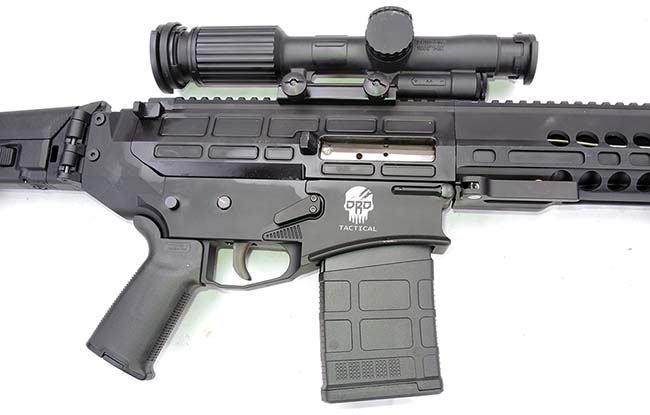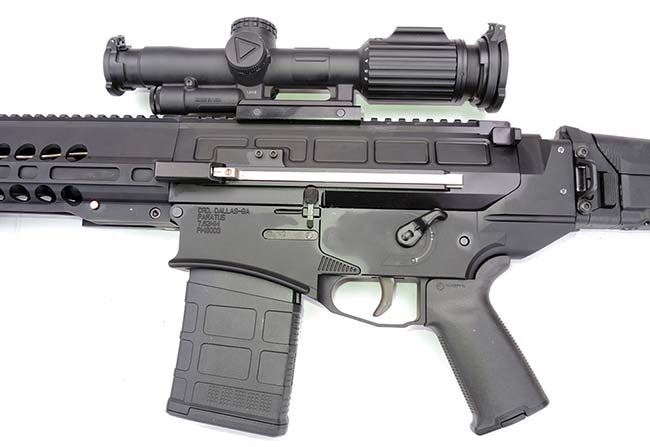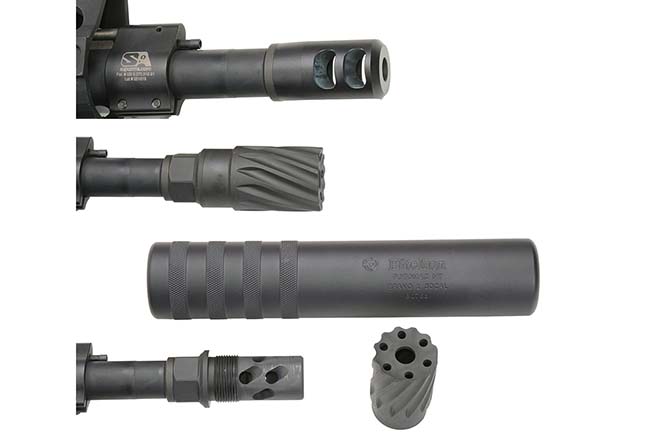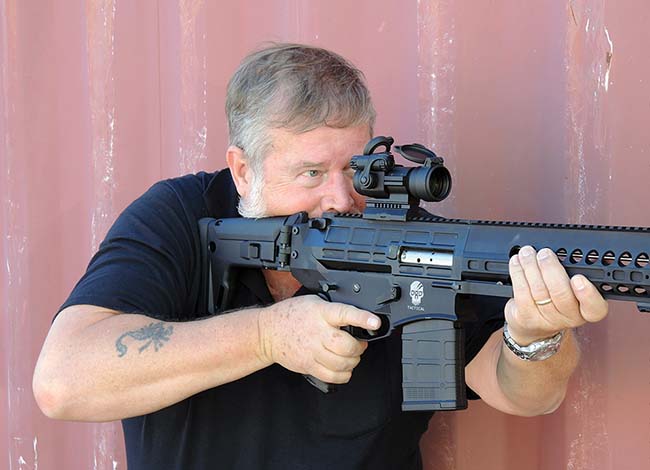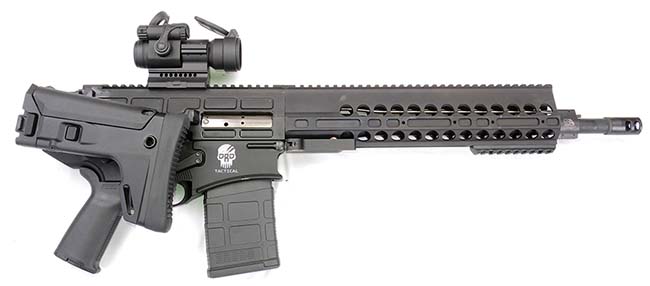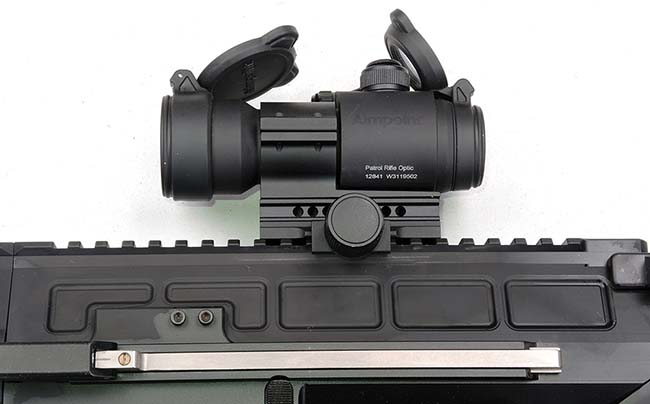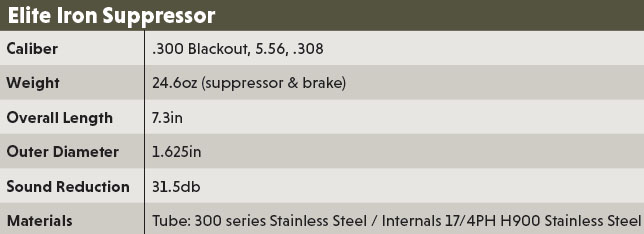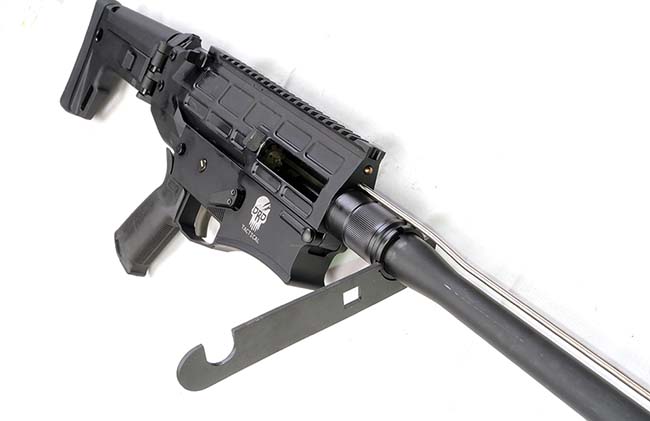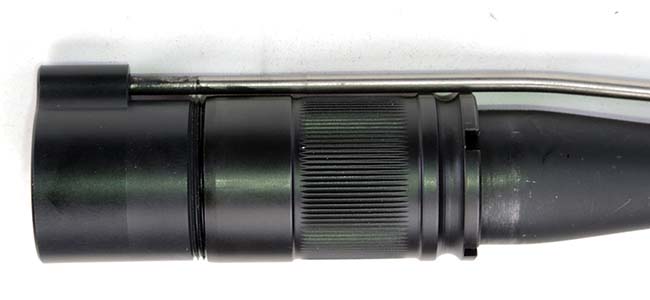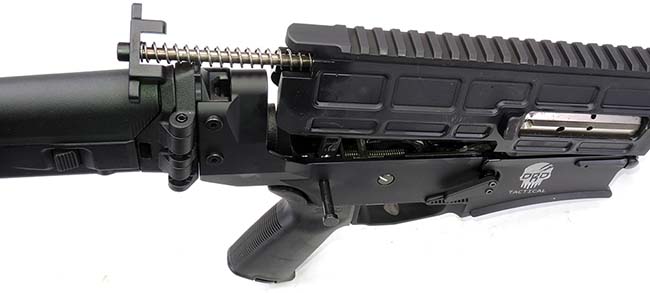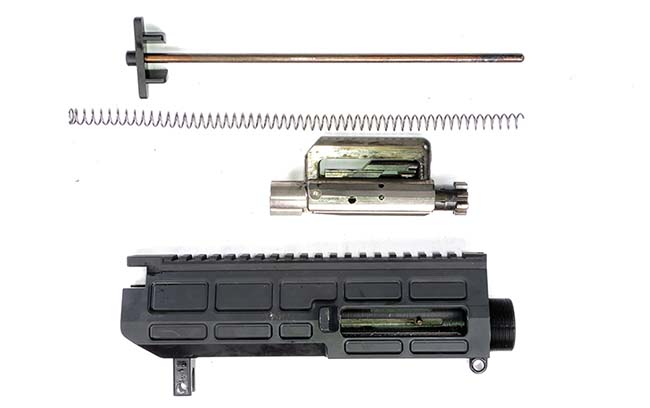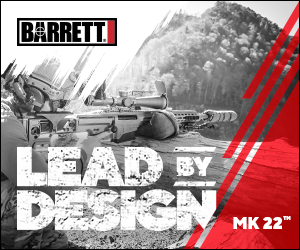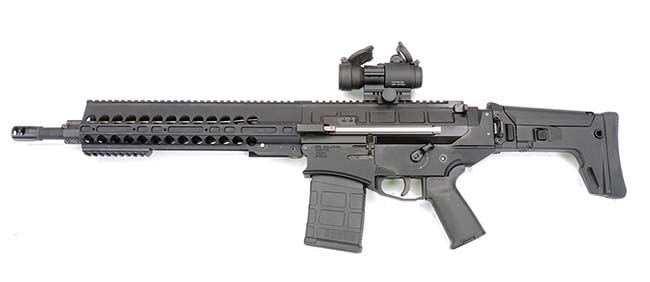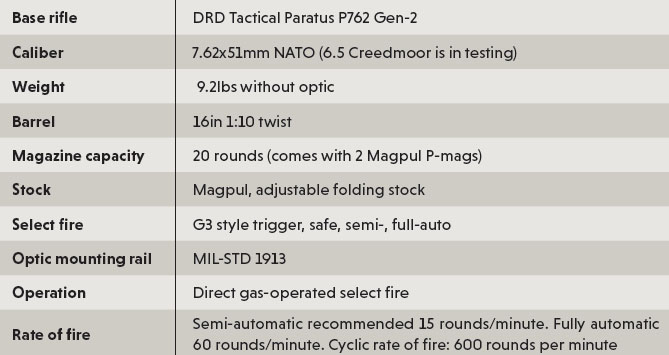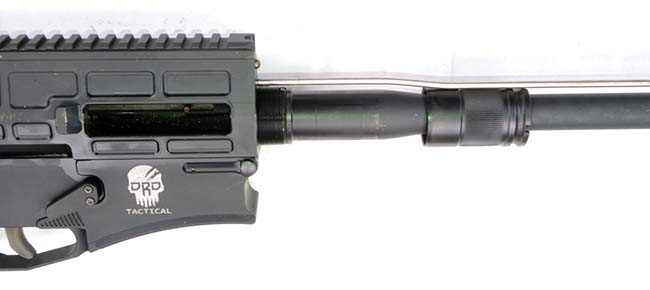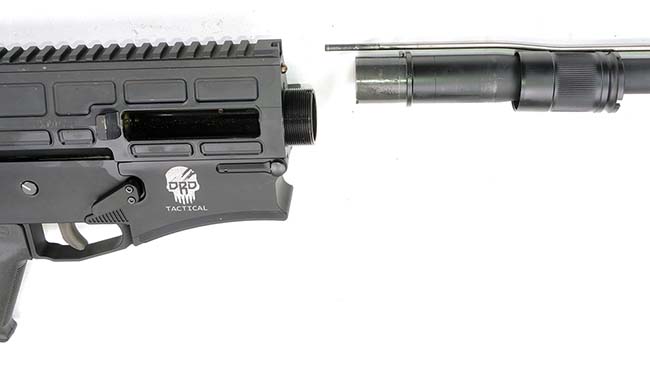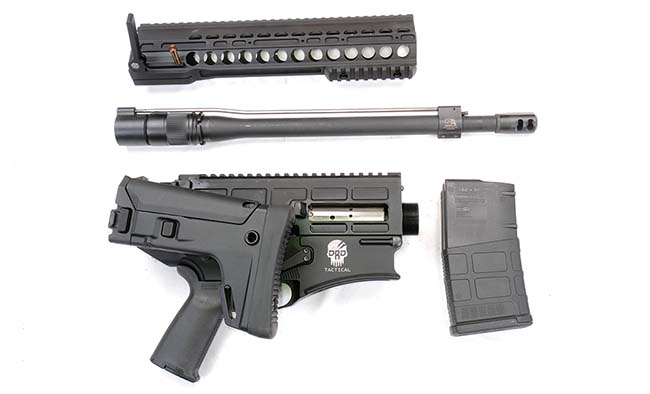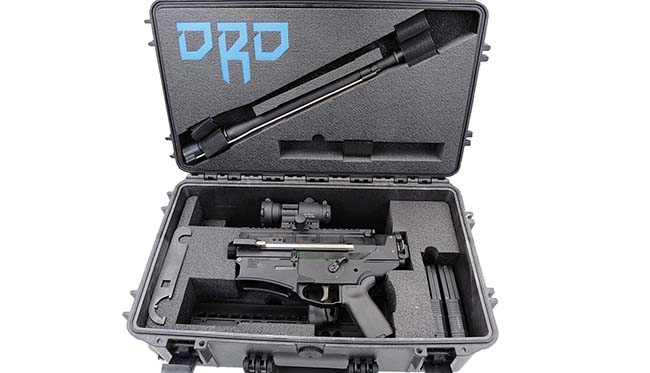ABOVE: Right side view of Paratus select-fire DMR, with Trijicon VCOG 1×6 optic, Elite Iron Bravo 1 suppressor and Harris bipod with cant lock.
Longtime readers of Small Arms Defense Journal and Small Arms Review are probably aware of this author’s penchant for takedown, discreet firearms. High quality, accurate, effective, concealed DMR type packages that look innocuous and can be snapped quickly into action. One other focus has always been finding controllable, lightweight 7.62x51mm full autos. Yes, I was weaned on my beloved M16A1, and yes, I’ve tested, collected, trained with and used almost every 5.56mm rifle out there. They’re still all rifles with a restricted range and effect due to the cartridge, and in my heart I’m an old .30 cal/.45acp guy. After a lifetime of experience with FALs, M14s, G3s and countless other true battle rifles, I’m glad to see that the great-grandchildren of Gene Stoner’s AR-10 have been coming into their own of late as select-fire rifles. First, LMT and Law Enforcement International had their custom 7.62x51mm select-fire offering in Jordan, which evolved quickly into Great Britain’s current Designated Marksman’s Rifle, the L129A1 “Sharpshooter”—one hell of a rifle serving proudly and effectively in Afghanistan, but alas, no selector switch. Small Arms Defense Journal covered it in Volume 3, Number 3. Next, Patriot Ordnance Factory presented the P308FA, which Small Arms Defense Journal covered in Volume 8, Number 1. We were truly impressed with the small size, weight and amazing controllability of the POF offering. In Volume 9, Number 1, I covered the DRD Tactical Paratus takedown rifle, developing a whole backpack system for what I believe to be the best covert takedown DMR around. All of these articles are online at sadefensejournal.com.
Now, it all comes home together, and I’m happy to present the following article—Skip Patel has made the great leap forward—the Paratus in select fire opens up capabilities that I’ve been watching for …
In this age of body-armor-wearing bad guys, improvised armored vehicles, extended threat ranges and just a general need to exceed the 5.56mm capability restrictions, 7.62x51mm is a quickly available alternative rifle round. While USSOCOM and others work to define a new round from 6.5 Creedmoor, .260 Remington and other excellent performers, that old .308 round is in TO & E system and available. It’s also a proven battle round. When I tested the Paratus rifle from DRD Tactical, the fact that a basic Covrt18™ backpack from 5.11 could conceal a true DMR was mind-blowing. I couldn’t help but wonder what would happen if those capabilities were augmented by having a reliable select-fire capability. As long as it didn’t compromise the DMR aspect, it was a desirable upgrade.
Recent conversations with Skip Patel from DRD Tactical (DRD stands for Defense Research & Development) indicated that he was approaching that capability and that he had used a G3 S-E-F trigger pack inside his lower receiver. Aside from all the interesting possibilities incumbent with that, the G3 trigger pack is a good, solid, reliable trigger system, and it is a good fit to the Paratus. This change means that the upper and lower receiver and bolt carrier for the select-fire Paratus are not interchangeable with the semi-automatic version.
When viewing the Paratus MG, two distinct uses come to mind almost immediately: first, the Paratus as DMR with a selector switch as a backup battle rifle; and second, as a CQB weapon. In both cases, the concealable nature of the design allows the operator to discreetly get into position for use. Fired in fully automatic, the rate of fire is 600 rounds per minute, and it is a natural cyclic rate for the rifle.
For our testing, I first wanted to accessorize these two variations properly. For the DMR I went back to Trijicon’s VCOG 1×6 for an optic: This was the optic chosen for the backpack Paratus DMR system SADJ previously covered. It’s such a good pairing, that I kept it for this testing. In the first Paratus test I used a Gemtech Quicksand suppressor. For this test I used the Elite Iron Bravo 1 suppressor; a robust and effective suppressor that has a unique attachment system which switches out to an efficient muzzle brake, has a variety of caliber uses and is full auto rated for .30 caliber.
Harris bipod: I generally use the Harris HBRS that has 6-inch to 9-inch extendable legs and add the Picatinny rail adapter as well as the “S” lock lever for cant. I’m not fond of the side-to-side swivel on this type of setup, it adds weight that I don’t find necessary, but the lever for the cant lock is fast, sturdy and fine-tunes the rifle to level quickly on rough terrain.
Live firing of the DMR version was performed with both Black Hills 175 grain Match Hollow Point with a velocity of 2600 fps and M118LR from Lake City, my basic go-to 7.62x51mm rounds. Both provide muzzle energy in excess of 2600ft/lbs. It’s already a known fact that Paratus performs well and returns to zero on re-assembly. The changes DRD made to go select fire had no effect on that. I was concerned there might be a reduction in accuracy from the original Paratus, this turned out to not be the case at all. Both rounds were well within 1 MOA performance.
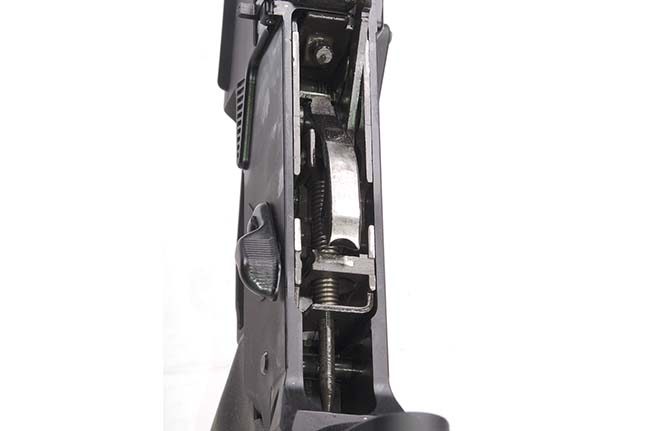
How controllable would a DMR setup be on select fire? That is the real question here. The idea is to switch from long-range firing to engaging close in threats and be ready to do so with a flip of the switch. The VCOG optic is perfect for that—given a decent longer range firing and being able to switch to the Trijicon both eyes open firing with the same scope.
With everything mounted on it, it was a bit heavy. However, we’re not asking the DMR to become an M240 suppressing fire at 1000 meters; we’re looking at close in threats with burst fire. I found the full auto setting to be very easy to get two round bursts and keep them on target. Very fast to switch from long-range semi-auto to close engagement bursts. It’s another tool in the assets for a DMR operator, without having to keep a second rifle. Success on this.
Changing to a CQB Configuration
For a CQB use, basically keeping the option of a suppressor, removing the bipod and switching the optic for something lighter and faster were important. The Aimpoint Patrol Rifle Optic was a good choice for this. At 9.2 pounds plus the ammo and optic, it’s not an M4. However, the Paratus in select fire is capable of packing up extremely small in a discreet backpack and becoming a robust 7.62x51mm jackhammer. It’s not supposed to be an M4. My goal was to fire two round bursts on target, quickly, so the 30-caliber double taps would engage any reasonable target short of rolling armor. I might be exaggerating a bit on that, but the Paratus was fast, accurate, the 600 rpm cyclic rate was within the harmonic of the rifle, and it was reliable. DRD has a very strong contender for the takedown rifle with serious power.
In conclusion, the Paratus in a select-fire configuration is a success. It gives a lot of options to an operator—like any good descendant of the Stoner system, it has configurations that can be opted for according to need. This rifle should be in consideration for any special operations needs that require discreet insertion of a weapon system into an area, with accurate fire and the added capability that the fully automatic 7.62x51mm can bring to the equation.
FOR MORE INFORMATION
drdtactical.com
Eliteiron.com
trijicon.com
aimpoint.com
harrisbipods.com
black-hills.com
